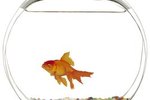
Chondrococcus columnaris looks like a fungal infection but, in reality, it's a bacterial infection that causes gruesome disfigurement and death in most kinds of fish. Tropical fish can get this condition, as well as coldwater fish. Saltwater fish are less likely to acquire the disease, as salt is one of the many treatments for the infection.
White Lines Around the Mouth
Usually the first signs of illness are a change in the color of the fish's lips. They mutate from their normal color to shades of white or gray. If the early signs aren't recognized right away, this leads to white hair-like sprouts emerging from the lips. This condition is in its early stages with these symptoms but is already contagious. The infected fish should be isolated in a separate tank for treatment at this point.
Clamped Fins and Lethargy
Clamping the fins and tail is common in sick fish and is one of the first signs that aquarists look for when purchasing new fish. It's also a sign of a stressed fish, and stress can lower immunity and promote disease. Lethargy is also common in most fish diseases and demonstrates the weakness of the sick fish. A lethargic fish just hangs in the water, refusing to swim or move around much, and doesn't look well.
Thickened Slime Coat
All fish have a slime coat covering their skin as a protective measure against infections. This is why fish are so slippery when held. Surprisingly enough, this coating grows thicker when chondrococcus columnaris is present. The disease causes the fish's colors to fade, and the scales look dull compared to their normal shiny appearance.
Rotting Flesh and Death
Eventually, if left untreated, the bacteria will eat away at the fish's lips, face, head and other parts of the body, including the internal organs. This condition is fatal for many reasons, among them being that the fish can't eat with rotting lips and so starves -- and it won't be able to digest anything anyway with rotting internal organs. The tail rots, fins rot, and whole patches of the fish's flesh dissolve away until the fish dies.
Treatments for Cotton Mouth
Several treatments for cotton mouth exist, and all are best when used early. Salt rubbed on the fish's mouth, using a damp cloth, heals the condition. Adding salt to the water treats all fish in the tank, and a small amount of methylene blue in the water treats fish in a few days. Dissolving terramycin and Aureomycin in water produces results within three days. A 5 percent silver mercury solution applied directly to the diseased areas also promotes healing.
References
- Tropical Fish Tanks Online: Treating Cotton Mouth Disease (Mouth Fungus)
- Petmanage.com: Diseases in Tropical Fish Mouth (Cotton Mouth) and Their Treatment
- Petfish.net -- Online Aquarist Community: Aquarium Fish Health: Dealing With Cotton Mouth Disease
- Desktop Goldfish: Goldfish Diseases -- Cotton Mouth
Photo Credits
-
Tom Brakefield/Stockbyte/Getty Images



